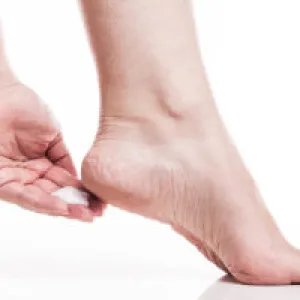Ouch! Have cracked heels come to plague you now that winter has been here for a while? The reasons for this painful condition may surprise you! Let’s take a look and then figure out how to support your feet and say goodbye to this nuisance.
If you have suffered from cracked heels, you may believe it is simply dry skin that’s been ignored for too long. Well, yes and no. Truly, your skin is dry but it can be so for a variety of reasons. Also, it is not something with which to mess around. When cracks start to form, they are extremely painful and can bleed. Once this happens you are vulnerable to infection.
Some reasons for cracked heels may be:
- Exposure to weather extremes including wind, cold, and heat
- Not enough healthy fat in the diet! (This surprised me.)
- Wearing sandals and not using a quality pumice stone and lotion regularly
- Dehydration
- Athlete’s foot
- Poor circulation
Okay, regardless of the cause, let’s get down to supporting your feet. First, I would say that if your heels are at the point where they are bleeding, please see a specialist, particularly if you are diabetic. The doctor needs to know about this immediately.
If you are feeling pain from dryness at the heel or have minor cracks, here’s a game plan to try. For many, this will resolve the issue in three or four days of faithful care.
First, wash feet and dry thoroughly. If no cracks are present yet, lightly remove dry skin with a gentle pumice stone. Sorry those “grater eggs” advertised on TV are too harsh for this condition and may further damage your skin. If you already have cracks in the skin, skip the pumice stone until they heal.
Second, make an essential oil ointment using coconut oil, high quality lavender essential oil and either melaleuca alternifolia (TeaTree) essential oil or a proprietary blend of TeaTree known as Melrose. A drop of Cypress essential oil is optional to aid in circulation.
Third, once the ointment soaks in, coat heel with a thick, high quality, pure lavender lotion or pure organic shea butter. (Note: Shea butter is a nut butter so if you have a nut allergy please avoid.)
Fourth, coat heel with a thick healing ointment such as Rose Ointment to seal in moisture. Cover with socks.
Finally, take a tablespoon of healthy Omega-3 fat, twice daily, in the morning and before bed. Drink plenty of water!
Ahh… soft, beautiful, healthy heels!
Cracked Heel Balm
Quality care for feet is critically important.

Ingredients
- 1 Tbs of Coconut Oil
- 3-5 drops of Lavender Essential Oil
- 3-5 drops of TeaTree (melaleuca alternifolia) Essential Oil or Melrose Essential Oil
- Optional: 1 drop of Cypress Essential Oil
- Clean glass 1 ounce jar or a sturdy plastic disposible "salad dressing" cup with top.
- Apply to cracked heels morning and night. After application, put a thick lavender lotion or shea butter on heel. Before putting on socks, add a thin layer of Rose Ointment to seal in moisture.
- I only recommend Young Living therapeutic grade essential oils for this application.
- Lavender Essential Oil: Where to buy
- Tea Tree Essential Oil: Where to buy
- Cypress Essential Oil:Where to buy
- Or, just visit www.kathymcdaniel.com, press the contact button and I can help you get the deepest discount possible.
Instructions
- Add coconut oil to small jar.
- With a toothpick, stir in the essential oils and mix well.
- Cover and refrigerate until firm.


